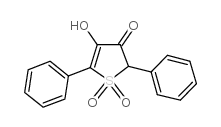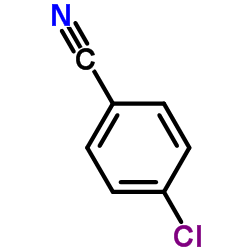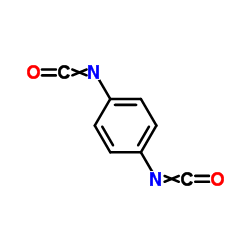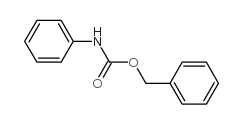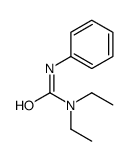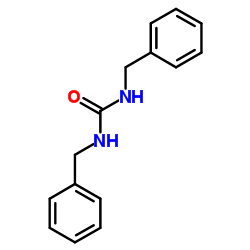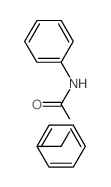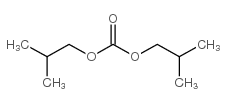54714-11-3
| 中文名 | 4,6-二苯基噻吩[3,4-D]-1,3-二氧代-2-酮-5,5-二氧化物 |
|---|---|
| 英文名 | 4,6-Diphenylthieno[3,4-d]-1,3-dioxol-2-one 5,5-Dioxide |
| 中文别名 |
4,6-二苯基噻吩[3,4-d]-1,3-二氧-2-酮-5,5-二氧
4,6-二苯基噻吩[3,4-d]-1,3-二氧代-2-酮-5,5-二氧化物 |
| 英文别名 |
4,6-diphenylthieno[3,4-d]-1,3-dioxol-2-one 5,5-dioxide
Thieno[3,4-d]-1,3-dioxol-2-one, 4,6-diphenyl-, 5,5-dioxide 4,6-diphenyl-5H-5λ-thieno[3,4-d][1,3]dioxole-2,5,5-trione 4,6-diphenylthieno(3,4-d)(1,3)dioxol-2-one-5,5-dioxide 4,6-Diphenylthieno(3,4-d)-1,3-dioxol-2-one 5,5-dioxide 4,6-Diphenylthieno[3,4-d][1,3]dioxol-2-one 5,5-dioxide EINECS 259-301-2 MFCD00040564 |
| 密度 | 1.6±0.1 g/cm3 |
|---|---|
| 沸点 | 543.6±60.0 °C at 760 mmHg |
| 熔点 | 270-275°C |
| 分子式 | C17H10O5S |
| 分子量 | 326.323 |
| 闪点 | 282.6±32.9 °C |
| 精确质量 | 326.024902 |
| PSA | 85.87000 |
| LogP | 4.49 |
| 外观性状 | 固体;Light yellow to Yellow to Orange powder to crystal |
| 蒸汽压 | 0.0±1.5 mmHg at 25°C |
| 折射率 | 1.710 |
| 储存条件 | 保持贮藏器密封、储存在阴凉、干燥的地方,确保工作间有良好的通风或排气装置 |
| 稳定性 | 如果遵照规格使用和储存则不会分解,未有已知危险反应 |
| 计算化学 | 1.疏水参数计算参考值(XlogP):2.7 2.氢键供体数量:0 3.氢键受体数量:5 4.可旋转化学键数量:2 5.互变异构体数量:无 6.拓扑分子极性表面积78 7.重原子数量:23 8.表面电荷:0 9.复杂度:631 10.同位素原子数量:0 11.确定原子立构中心数量:0 12.不确定原子立构中心数量:0 13.确定化学键立构中心数量:0 14.不确定化学键立构中心数量:0 15.共价键单元数量:1 |
| 更多 | 1. 性状:固体 2. 密度(g/mL,20ºC):未确定 3. 相对蒸汽密度(g/mL,空气=1): 未确定 4. 熔点(ºC):270-275 5. 沸点(ºC):未确定 6. 沸点(ºC,0.1mm hg):未确定 7. 折射率:未确定 8. 闪点(°C):未确定 9. 比旋光度(ºC):未确定 10. 自燃点或引燃温度(ºC): 未确定 11. 蒸气压(kPa,25ºC):未确定 12. 饱和蒸气压(kPa,60ºC):未确定 13. 燃烧热(KJ/mol):未确定 14. 临界温度(ºC):未确定 15. 临界压力(KPa):未确定 16. 油水(辛醇/水)分配系数的对数值:未确定 17. 爆炸上限(%,V/V):未确定 18. 爆炸下限(%,V/V):未确定 19. 溶解性:未确定 |
|
Section I.Chemical Product and Company Identification Chemical Name 4,6-Diphenylthieno[3,4-d]-1,3-dioxol-2-one 5,5-Dioxide Portland OR Synonym Not available.
Chemical Formula C 17 H 10 O 5 S CAS Number 54714-11-3 (International) Section II.Composition and Information on Ingredients Toxicology Data Chemical NameCAS Number Percent (%)TLV/PEL 4,6-Diphenylthieno[3,4-d]-1,3-dioxol-2-one54714-11-3----------Not available.Not available. 5,5-Dioxide Section III.Hazards Identification Acute Health Effects Irritating to eyes and skin on contact. Inhalation causes irritation of the lungs and respiratory system . Inflam m ation of the eye is characterized by redness, w atering, and itching. Skin inflam m ation is characterized by itching, scaling, reddening, or, occasionally, blistering. Follow safe industrial hygiene practices and alw ays w ear proper protective equipment when handling this compound. Chronic Health EffectsCARCINOGENIC EFFECTS : Not available. MUTAGENIC EFFECTS : Not available. TERATOGENIC EFFECTS : Not available. DEVELOPMENTAL TOXICITY : Not available. There is no know n effect from chronic exposure to this product.Repeated or prolonged exposure to this com pound is not known to aggravate existing medical conditions. Section IV.First Aid Measures Eye Contact C heck for and rem ove any contact lenses. D O N O T use an eye ointm ent. Flush eyes w ith running w ater for a m inim um of 15 m inutes, occasionally lifting the upper and low er eyelids. Seek m edical attention. Treat sym ptom atically and supportively. Skin Contact A fter contact w ith skin, w ash im m ediately w ith plen ty of w ater. G ently and thoroughly w ash the contam inated skin w ith running w ater and non-abrasive soap. Be particularly careful to clean folds, crevices, creases and groin. C over the irritated skin w ith an em ollient. Seek m edical attention. Treat sym ptom atically and supportively. W ash any contaminated clothing before reusing. Inhalation If the victim is not breathing, perform artificial respiration. Loosen tight clothing such as a collar, tie, belt or w aistband. If breathing is difficult, oxygen can be administered. Seek medical attention. Treat symptomatically and supportively. Ingestion D O N O T induce vom iting. Loosen tight clothing such as a collar, tie, belt, or w aistband. If the victim is not breathing, adm inister artificial respiration. Exam ine the lips and m outh to ascertain w hether the tissues are dam aged, a possible indication that the toxic m aterial w as ingested; th e absence of such signs, how ever, is not conclusive. Seek im m ediate medical attention and, if possible, show the chemical label. Treat symptomatically and supportively. Section V.Fire and Explosion Data Auto-Ignition FlammabilityNot available. Combustible. Flash PointsFlammable Limits Not available. Not available. Combustion Products These products are toxic carbon oxides (CO, CO2), sulfur oxides (SOx ). Fire Hazards No specific information is available regarding the flammability of this compound in the presence of various materials. Explosion Hazards Risks of explosion of the product in presence of mechanical impact: Not available. Risks of explosion of the product in presence of static discharge: Not available. No additional information is available regarding the risks of explosion. Fire Fighting Media SMALL FIRE: Use DRY chemicals, CO2, water spray or foam. and InstructionsLARGE FIRE: Use water spray, fog or foam. DO NOT use water jet. Continued on Next Page D22pp4,6-Diphenylthieno[3,4-d]-1,3-dioxol-2-one 5,5-Dioxide Section VI.Accidental Release Measures Spill Cleanup Irritating material. InstructionsIn case of a spill and/or a leak, alw ays shut off any sources of ignition, ventilate the area, and exercise caution. U se a shovel to put the m aterial into a convenient w aste disposal container. Finish cleaning the spill by rinsing any contam inated surfaces w ith copious am ounts of w ater. C onsult federal, state, and/or local authorities for assistance on disposal. Section VII.Handling and Storage Handling and Storage IRRITA N T. K eep aw ay from heat and sources of ignition. M echanical exhaust required. W hen not in use, tightly seal the container and store in a dry, cool place. A void excessive heat and light. D O N O T ingest. D O N O T breathe dust. In case Information of insufficient ventilation, w ear suitable respiratory equipm ent. If ingested, seek m edical advice im m ediately and show the container or the label. Treat symptomatically and supportively. Avoid contact with skin and eyes. Always store away from incompatible compounds such as oxidizing agents, metals, acids. Section VIII.Exposure Controls/Personal Protection Engineering Controls U se process enclosures, local exhaust ventilation, or other engineering controls to keep airborne levels below recom m ended exposure lim its. If user operations generate dust, fum e or m ist, use ventilation to keep exposure to airborne contaminants below the exposure limit. Personal Protection Splash goggles. Lab coat.D ust respirator. Boots. G loves. A M SH A /N IO SH approved respirator m ust be used to avoid inhalation of the product.Suggested protective clothing m ight not be sufficient; consult a specialist BEFO RE handling this product. Exposure Limits Not available. Section IX.Physical and Chemical Properties Physical state @ 20°CSolubility Yellow powder. Not available. Specific Gravity Not available. Molecular WeightPartition Coefficient 326.33Not available. Boiling PointVapor Pressure Not available.Not available. Melting PointVapor Density 230 to 290°C (446 to 554°F)Not available. Refractive IndexVolatility Not available.Not available. Critical TemperatureOdor Not available.Not available. ViscosityTaste Not available.Not available. Section X.Stability and Reactivity Data Stability This material is stable if stored under proper conditions. (See Section VII for instructions) Conditions of Instability Avoid excessive heat and light. Incompatibilities Reactive with oxidizing agents, bases, acids. Section XI.Toxicological Information RTECS Number Not available. Routes of ExposureEye contact. Inhalation. Ingestion. Skin contact. Toxicity Data Not available. Chronic Toxic EffectsCARCINOGENIC EFFECTS : Not available. MUTAGENIC EFFECTS : Not available. TERATOGENIC EFFECTS : Not available. DEVELOPMENTAL TOXICITY : Not available. There is no know n effect from chronic exposure to this product.Repeated or prolonged exposure to this com pound is not known to aggravate existing medical conditions. Acute Toxic Effects Irritating to eyes and skin on contact. Inhalation causes irritation of the lungs and respiratory system . Inflam m ation of the eye is characterized by redness, w atering, and itching. Skin inflam m ation is characterized by itching, scaling, reddening, or, occasionally, blistering. Follow safe industrial hygiene practices and alw ays w ear proper protective equipment when handling this compound. Continued on Next Page 4,6-Diphenylthieno[3,4-d]-1,3-dioxol-2-one 5,5-Dioxide Section XII.Ecological Information Ecotoxicity Not available. Environmental Fate Not available. Section XIII.Disposal Considerations Waste Disposal Recycle to process, if possible. C onsult your local or regional authorities. You m ay be able to dissolve or m ix m aterial w ith a com bustible solvent and burn in a chem ical incinerator equipped w ith an afterburner and scrubber system . Observe all federal, state, and local regulations when disposing of this substance. Section XIV.Transport Information DOT Classification Not a DOT controlled material (United States). PIN Number Not applicable. Proper Shipping Name Not applicable. Packing Group (PG) Not applicable. DOT Pictograms Section XV.Other Regulatory Information and Pictograms TSCA Chemical InventoryT h is p r o d u c t is NOT o n t h e E P A T o x ic S u b s t a n c e s C o n t r o l A c t (T S C A ) in v e n t o r y . T h e f o llo w in g n o t ic e s a r e r e q u ir e d b y 4 0 (EPA)CFR 720.36 (C) for those products not on the inventory list: (i) These products are supplied solely for use in research and developm ent by or under the supervision of a technically qualified individual as defined in 40 CFR 720.0 et sec. (ii) The health risks of these products have not been fully determ ined. A ny inform ation that is or becom es available w ill be supplied on an MSDS sheet. WHMIS Classification WHMIS CLASS D-2A: Material causing other toxic effects (VERY TOXIC). (Canada) EINECS Number (EEC) 259-301-2 EEC Risk Statements R36/37/38- Irritating to eyes, respiratory system and skin. SECTION 16 - ADDITIONAL INFORMATION N/A |
|
生态学数据: 对水是稍微有危害的不要让未稀释或大量的产品接触地下水、水道或者污水系统,若无政府许可,勿将材料排入周围环境。
|
| 符号 |

GHS07 |
|---|---|
| 信号词 | Warning |
| 危害声明 | H315-H319-H335 |
| 警示性声明 | P261-P305 + P351 + P338 |
| 个人防护装备 | dust mask type N95 (US);Eyeshields;Gloves |
| 危害码 (欧洲) | Xi: Irritant; |
| 风险声明 (欧洲) | R36/37/38 |
| 安全声明 (欧洲) | S26-S36-S37/39 |
| 危险品运输编码 | NONH for all modes of transport |
| 海关编码 | 2932999099 |
|
~% 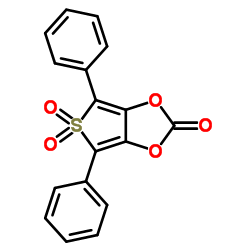
54714-11-3 |
| 文献:US4122090 A1, ; |
| 上游产品 2 | |
|---|---|
| 下游产品 8 | |
| 海关编码 | 2932999099 |
|---|---|
| 中文概述 | 2932999099. 其他仅含氧杂原子的杂环化合物. 增值税率:17.0%. 退税率:13.0%. 监管条件:无. 最惠国关税:6.5%. 普通关税:20.0% |
| 申报要素 | 品名, 成分含量, 用途 |
| Summary | 2932999099. other heterocyclic compounds with oxygen hetero-atom(s) only. VAT:17.0%. Tax rebate rate:13.0%. . MFN tariff:6.5%. General tariff:20.0% |



